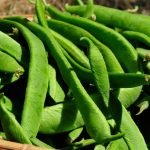
My kitchen counter has transitioned from the tomatoes and tomatillos of late summer.
The new arrangement of hops, shallots, “Sunshine” kabocha and “Trombetta” squashes, walnuts, red serrano peppers, along with a branch of sweet bay, is both a celebration of fall and an anticipation of Thanksgiving family visitors from Boston, San Francisco, Irvine and Sacramento.
While my edible garden supplies ample material for artistic arrangements, I did not want to be without a bay tree (Laurus nobilis).
Planted 40 years ago when I first arrived, the deer destroyed my first attempts to grow this beautiful evergreen tree. Serious protection was in order for several years after planting.
CARE FOR THE TREES
Fortunately, while slow in growth, the bay was eventually out of reach from the deer. Over the decades, it became quite a sizable “small” tree in my landscape. Even after having it topped by 20 feet when tree trimmers were doing work for me, it is now well over 25 feet in height.
I would not ordinarily top a tree, but I was certain this would encourage the bay to grow more densely. It did.
Surprisingly, the deer now do very little damage to the lush lower growth, though it is definitely in their preferred corridor outside the wood fence.
Friends in Nevada City recently reminded me that the oakleaf hydrangea (Hydrangea quercifolia) has outstandingly beautiful leaves in November.
The size, the shape, and the colors all add to a natural fall display in the garden and on the dining table. While considered to be a “deer-resistant” hydrangea by many nurseries, it has not been in my garden.
GROWING BULBS
Early-blooming late winter and early spring bulbs are already appearing in the garden, their foliage adding a bright green accent along my paths. While bloom is yet weeks away, I am reminded to add a few more bulbs.
My method, both to save time and to avoid digging up bulbs planted in previous years, is to plant in containers.
Take advantage of the dwindling supply of bulbs in local nurseries, or order online from a reputable bulb supplier. I order from VanEngelen or Brent & Becky’s Bulbs.
While many bulbs available earlier in fall are sold out, some favorites (Narcissus, Muscari, Tulipa) may still be found.
I prefer to use two-gallon nursery containers for the larger bulbs. One-gallon containers work for the smaller. Sturdy peat pots may also be used, but the bottoms will soon decompose.
A three to four-inch layer of “Carolyn’s Mix” from Rare Earth is placed in the bottom of the container.
While this compost mix already has phosphorus in it, I add more. A couple of tablespoons of colloidal phosphorus, rock phosphate or raw rock phosphate mixed into the compost. Bulbs may be placed close together.
More compost is added over the bulbs, but first I add a quarter of a cup of perlite per container. This ensures adequate drainage if rains keep the container continually moist.
Planted containers are placed in shade on the north side of a building, or covered with shade cloth. This method delays growth, allowing good root development. Check the containers in a few weeks.
Once new growth emerges, the bulbs need more light, but not direct sunlight. Light shade cloth (30 percent) is a good cover at this stage if the containers are in full late-winter sun.
Because the deer (so far) are not on my porch, being able to enjoy tulips in containers satisfies my craving for this spectacular spring flower. The heady fragrance of large hyacinth adds its later accent.
After bloom, the containers are placed again in semi-shade, the foliage allowed to fade naturally. Perfect for those gardeners who fuss over their landscapes!
Container-grown bulbs may be removed from the pot and planted into the garden.
Any stage of development works: as soon as the bulb foliage emerges, before, during, or after bloom or even in summer months when the bulbs are dormant. Add more phosphorus below the roots when you replant in a new location.
Bulbs add to the water-efficient landscape for many years.
[“Source-theunion”]










